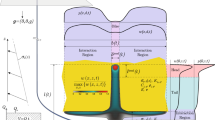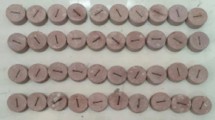Abstract
The flow direction of fracture water and heat transfer directly affects the temperature field, water flow field, and nuclide migration in the near field of high-level radioactive waste repository. Compared with the general model of the same direction of fracture water flow and heat transfer in fractured rock mass, diversified directions of water flow and heat transfer in the disposal repository have been put forward in this paper. The influence of different flow directions of fracture water and heat transfer on the near field temperature of the repository was analyzed, which was significant to certain engineering application. Based on the conceptual model of fracture water flow and heat transfer, the influence of fracture water flow and heat transfer direction on the temperature of the repository was analyzed by using the 3 Dimension Distinct Element Code program. The results show that when the heat source release was about 0.896 month, the heat conduction between the fracture outlet water flow and the rock started to the couple, and the time required for the model to reach the steady state was about 43 months. When the flow direction of fracture water was the same, it was beneficial to the water flow to take away the heat in the near field of the repository. Conversely, this was not conducive for the water flow to take away the heat of the repository.








Similar content being viewed by others
References
Äikäs T (2011) Disposal of spent nuclear fuel-from plans to reality. World tunnel congress and 37th general assembly, Helsinki, pp 5.
Armand G, Bumbieler F, Conil N, VaissièreaJ R, Bosgiraud JM, Vub MN (2017) Main outcomes from in situ thermo-hydro-mechanical experiments programme to demonstrate feasibility of radioactive high-level waste disposal in the Callovo-Oxfordian claystone. J Rock Mech Geotech Eng 9(3):415–427. https://doi.org/10.1016/j.jrmge.2017.03.004
Ballarini E, Graupner B, Bauer S (2017) Thermal-hydraulic-mechanical behavior of bentonite and sand-bentonite materials as seal for a nuclear waste repository: numerical simulation of column experiments. Appl Clay Sci 135:289–299. https://doi.org/10.1016/j.clay.2016.10.007
China Nuclear Power Engineering Co., Ltd (2011) Conceptual design of underground laboratory and disposal library for high-level radioactive waste. China national defense science and technology report, Beijing.
Derakhshannia M, Dalvand S, Asakereh B, Askari K (2020) Corrosion and deposition in Karoon River, Iran, based on hydrometric stations. Int J Hydrol Sci Technol 10(40):334–345. https://doi.org/10.1504/IJHST.2020.108264
Fall M, Nasir O, Nguyen TS (2014) A coupled hydro-mechanical model for simulation of gas migration in host sedimentary rocks for nuclear waste repositories. Eng Geol 176:24–44. https://doi.org/10.1016/j.enggeo.2014.04.003
Gao JY, Xiang YY (2017) Three dimensional discrete element analysis of influence of fracture water flow and heat transfer on evolution temperature in near field of high level radioactive waste repository. At Energy Sci Technol 51(2):372–379
Gao JY, Xiang YY, Wu Q, Yang HX (2019) 3-D numerical analysis of the influence of fracture water flow and heat transfer at different locats on near-field temperature of HLW. J Beijing Jiaotong Univ 43(04):37–44
Gao JY (2021) Numerical analysis of the influence of the number of waste canister in borehole on the temperature, stress, and displacement in the near field of the high-level waste repository. Arab J Chem 14(10). https://doi.org/10.1007/S12517-021-07267-0.
Guo RP (2017) Thermal response of a Canadian conceptual deep geological repository in crystalline rock and a method to correct the influence of the near-field adiabatic boundary condition. Eng Geol 218:50–62. https://doi.org/10.1016/j.enggeo.2016.12.014
Golian M, Katibeh H, Singh VP, Ostad-Ali-Askari K, Rostami HT (2020) Prediction of tunnelling impact on flow rates of adjacent extraction water wells. Q J Eng GeolHydrogeol 53(2):236. https://doi.org/10.1144/qjegh2019-055
Hadgu T, Karra S, Kalinina E, Makedonska N (2017) A comparative study of discrete fracture network and equivalent continuum models for simulating flow and transport in the far field of a hypothetical nuclear waste repository in crystalline host rock. J Hydrol 553:59–70. https://doi.org/10.1016/j.jhydrol.2017.07.046
Hafshejani SS, Shayannejad M, Broujeni HS, Zarraty AR, Koa A (2019) Determination of the height of the vertical filter for heterogeneous earth dams with vertical clay core. Int J Hydrol Sci Technol 9(3):221–235. https://doi.org/10.1504/IJHST.2019.102315
Israil M, Ashraf M, Fahim M, Rehan R, Khan S W, Hussain S (2020) Evaluation of bentonite mixed indigenous clays for development of clay liners. Civ Eng J 6:24–32. https://doi.org/10.28991/cej-2020-SP(EMCE)-03
Joyce S, Hartley L, Applegate D, Hoek J, Jackson P (2014) Multi-scale groundwater flow modeling during temperate climate conditions for the safety assessment of the proposed high-level nuclear waste repository site at Forsmark. Sweden Hydrogeol J 22(6):1233–1249. https://doi.org/10.1007/s10040-014-1165-6
Javadinejad S, Ostad-Ali-Askari K, Jafary F (2019) Using simulation model to determine the regulation and to optimize the quantity of chlorine injection in water distribution networks. Model Earth Syst Environ 5(3):1015–1023. https://doi.org/10.1007/s40808-019-00587-x
Kaveh O-A-A, Mohammad S, Saeid E, Bahareh N (2018) Comparison of solutions of Saint-Venant equations by characteristics and finite difference methods for unsteady flow analysis in open channel. Int J Hydrol Sci Technol 8(3):229–243. https://doi.org/10.1504/IJHST.2018.093569
Lu W, Xiang YY, Li T (2011) A physical modeling study of water flow and heat transfer in un-filled fractured rocks. Chin J Rock Mech Eng Supp 2:3884–3891
Li N, Yao L, Lu KK, Wang Q (2012) The design of high level radioactive waste disposal container.in: Proceedings of the 4th symposium on underground waste disposal, Nanchang, Jiangxi, pp 23–27.
Liu WG, Wang J, Zhou HW, Yang CH, Jiang PF (2009) Coupled thermo-mechanical analysis of granite for high-level radioactive waste repository. Chin J Rock Mech Eng 28(Supp. 1):2875–2882
Ma YQ, Zhang YJ , Yu ZW , Huang YB, Zhang C (2018) Heat transfer by water flowing through rough fractures and distribution of local heat transfer coefficient along the flow direction. Int J Heat Mass Transf 119:139–147. https://doi.org/10.1016/j.ijheatmasstransfer.2017.11.102
Mihajlović G, Živković M (2020) Sieving extremely wet earth mass by means of oscillatory transporting platform. Emerg Sci J 4(3):172–182. https://doi.org/10.28991/esj-2020-01221
Nguyen TS, Li ZZ, Su G, Nasseri MHB, Young RP (2018) Hydro-mechanical behavior of an argillaceous limestone considered as a potential host formation for radioactive waste disposal. J Rock Mech Geotech Eng 6:1063–1081. https://doi.org/10.1016/j.jrmge.2018.03.010
Ostad-Ali-Askar K, Su R, Liu L (2018) Water resources and climate change. Journal of Water and Climate Change 9(2):239. https://doi.org/10.2166/wcc.2018.999
Ostad-Ali-Askari K, Shayannejad M (2021) Quantity and quality modelling of groundwater to manage water resources in Isfahan-Borkhar Aquifer. Environ Dev Sustain 23(3). https://doi.org/10.1007/s10668-021-01323-1
de La V, Rémi AG, Talandier J (2015) Gas and water flow in an excavation-induced fracture network around an underground drift: a case study for a radioactive waste repository in clay rock. J Hydrol 521:141–156. https://doi.org/10.1016/j.jhydrol.2014.11.067
Vanani HR, Shayannejad M, Soltani Tudeshki AR, Ali A, Eslamian S, Mohri-Esfahani E, Haeri-Hamedani M, Jabbari H (2017) Development of a new method for determination of infiltration coefficients in furrow irrigation with natural non-uniformity of slope. Sustain Water Resour Manag 3:163–169. https://doi.org/10.1007/s40899-017-0091-x
Wang S (2014) Numerical simulation of two-dimension thermo mechanical coupling in nuclear waste repository. Journal of Shenyang University (natural Science) 26(3):234–238
Wang YP, Xiong LX (2020) Numerical analysis of the influence of bolt set on the shear resistance of jointed rock masses. Civ Eng J 6(6), 1039–1055. https://doi.org/10.28991/cej-2020-03091527
Yan CZ, Jiao YY (2019) FDEM‐TH3D: A three-dimensional coupled hydrothermal model for fractured rock. Int J Numer Anal Methods Geomech 43:415–440. https://doi.org/10.1002/nag.2869
Zhang Y, Xiang YY (2013) A semi-analytical method for calculation of three-dimensional water flow and heat transfer in single-fracture rock with distributed heat sources. Rock & Soil Mechanics 34(3):685–695
Zhang Y, Xiang YY (2014) A semi-analytical modeling approach for three-dimensional heat transfer in sparsely fractured rocks with water flow and distributed heat source. Int J Numer Anal Meth Geomech 38(11):1149–1171. https://doi.org/10.1002/nag.2252
Zhao HG, Wang J, Su R (2014) Thermal dimension analysis of the HLW horizontal disposal. World Nuclear Geoscience 31(s1):305–312
Zhang CL (2018) Thermo-hydro-mechanical behavior of clay rock for deep geological disposal of high-level radioactive waste. J Rock Mech Geotech Eng 10(05):192–208. https://doi.org/10.1016/j.jrmge.2018.03.006
Funding
This study is sponsored by the Doctoral Research Initiation Project of Yan'an University under grant number YDBK2018-08, the Key Project of Open Fund of Shandong Lunan Geological Engineering Survey Institute under grant number LNYQ2021-Z06, and the Shandong Provincial Central Guide Local Science and Technology Development Fund Project under grant number YDZX20203700002937.
Author information
Authors and Affiliations
Corresponding author
Ethics declarations
Conflict of interest
The authors declare that they have no competing interests.
Additional information
Responsible Editor: Broder J. Merkel.
Rights and permissions
About this article
Cite this article
Gao, J., Zhang, Y., Shi, Q. et al. Analysis of the influence of the multi-fracture water flow and heat transfer direction on the near-field temperature of high-level radioactive waste repository. Arab J Geosci 14, 2481 (2021). https://doi.org/10.1007/s12517-021-08776-8
Received:
Accepted:
Published:
DOI: https://doi.org/10.1007/s12517-021-08776-8




